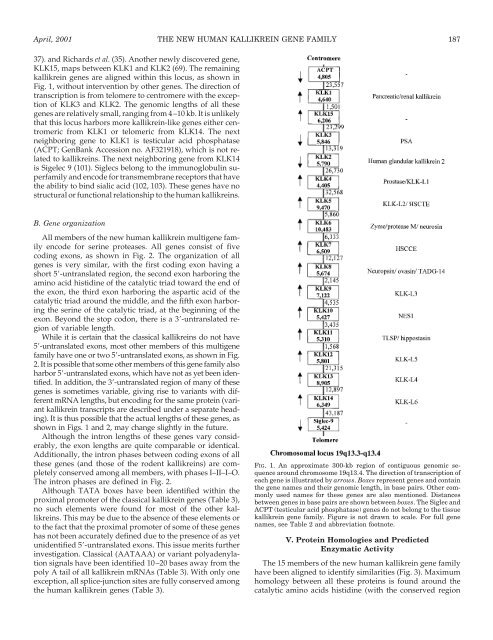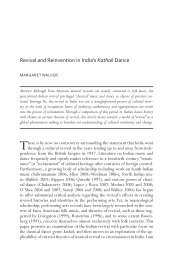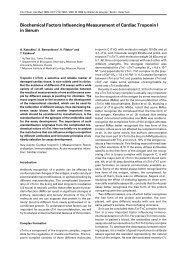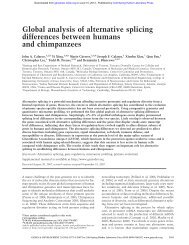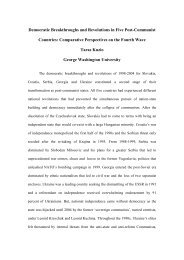The New Human Tissue Kallikrein Gene Family - Endocrine Reviews
The New Human Tissue Kallikrein Gene Family - Endocrine Reviews
The New Human Tissue Kallikrein Gene Family - Endocrine Reviews
You also want an ePaper? Increase the reach of your titles
YUMPU automatically turns print PDFs into web optimized ePapers that Google loves.
April, 2001 THE NEW HUMAN KALLIKREIN GENE FAMILY 18737). and Richards et al. (35). Another newly discovered gene,KLK15, maps between KLK1 and KLK2 (69). <strong>The</strong> remainingkallikrein genes are aligned within this locus, as shown inFig. 1, without intervention by other genes. <strong>The</strong> direction oftranscription is from telomere to centromere with the exceptionof KLK3 and KLK2. <strong>The</strong> genomic lengths of all thesegenes are relatively small, ranging from 4–10 kb. It is unlikelythat this locus harbors more kallikrein-like genes either centromericfrom KLK1 or telomeric from KLK14. <strong>The</strong> nextneighboring gene to KLK1 is testicular acid phosphatase(ACPT; GenBank Accession no. AF321918), which is not relatedto kallikreins. <strong>The</strong> next neighboring gene from KLK14is Sigelec 9 (101). Siglecs belong to the immunoglobulin superfamilyand encode for transmembrane receptors that havethe ability to bind sialic acid (102, 103). <strong>The</strong>se genes have nostructural or functional relationship to the human kallikreins.B. <strong>Gene</strong> organizationAll members of the new human kallikrein multigene familyencode for serine proteases. All genes consist of fivecoding exons, as shown in Fig. 2. <strong>The</strong> organization of allgenes is very similar, with the first coding exon having ashort 5-untranslated region, the second exon harboring theamino acid histidine of the catalytic triad toward the end ofthe exon, the third exon harboring the aspartic acid of thecatalytic triad around the middle, and the fifth exon harboringthe serine of the catalytic triad, at the beginning of theexon. Beyond the stop codon, there is a 3-untranslated regionof variable length.While it is certain that the classical kallikreins do not have5-untranslated exons, most other members of this multigenefamily have one or two 5-untranslated exons, as shown in Fig.2. It is possible that some other members of this gene family alsoharbor 5-untranslated exons, which have not as yet been identified.In addition, the 3-untranslated region of many of thesegenes is sometimes variable, giving rise to variants with differentmRNA lengths, but encoding for the same protein (variantkallikrein transcripts are described under a separate heading).It is thus possible that the actual lengths of these genes, asshown in Figs. 1 and 2, may change slightly in the future.Although the intron lengths of these genes vary considerably,the exon lengths are quite comparable or identical.Additionally, the intron phases between coding exons of allthese genes (and those of the rodent kallikreins) are completelyconserved among all members, with phases I–II–I–O.<strong>The</strong> intron phases are defined in Fig. 2.Although TATA boxes have been identified within theproximal promoter of the classical kallikrein genes (Table 3),no such elements were found for most of the other kallikreins.This may be due to the absence of these elements orto the fact that the proximal promoter of some of these geneshas not been accurately defined due to the presence of as yetunidentified 5-untranslated exons. This issue merits furtherinvestigation. Classical (AATAAA) or variant polyadenylationsignals have been identified 10–20 bases away from thepoly A tail of all kallikrein mRNAs (Table 3). With only oneexception, all splice-junction sites are fully conserved amongthe human kallikrein genes (Table 3).FIG. 1. An approximate 300-kb region of contiguous genomic sequencearound chromosome 19q13.4. <strong>The</strong> direction of transcription ofeach gene is illustrated by arrows. Boxes represent genes and containthe gene names and their genomic length, in base pairs. Other commonlyused names for these genes are also mentioned. Distancesbetween genes in base pairs are shown between boxes. <strong>The</strong> Siglec andACPT (testicular acid phosphatase) genes do not belong to the tissuekallikrein gene family. Figure is not drawn to scale. For full genenames, see Table 2 and abbreviation footnote.V. Protein Homologies and PredictedEnzymatic Activity<strong>The</strong> 15 members of the new human kallikrein gene familyhave been aligned to identify similarities (Fig. 3). Maximumhomology between all these proteins is found around thecatalytic amino acids histidine (with the conserved region


